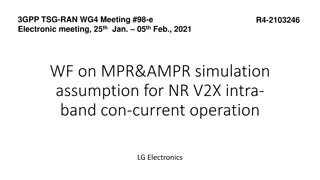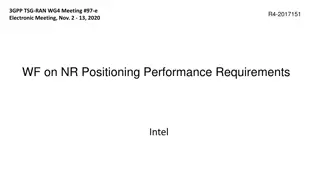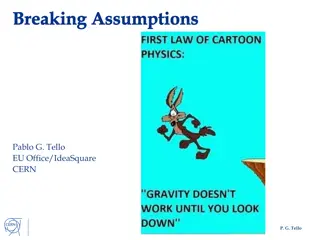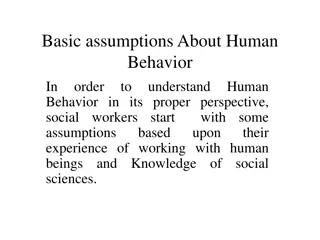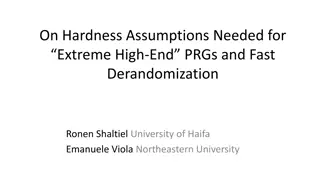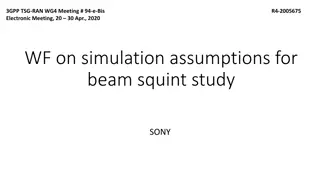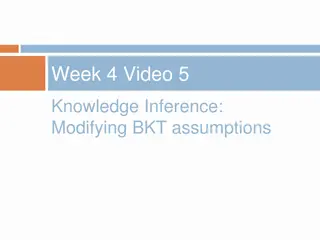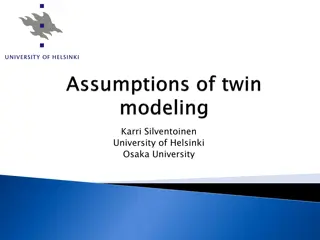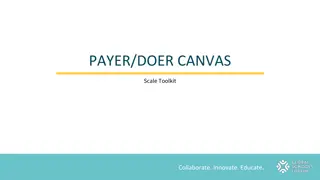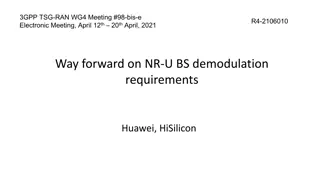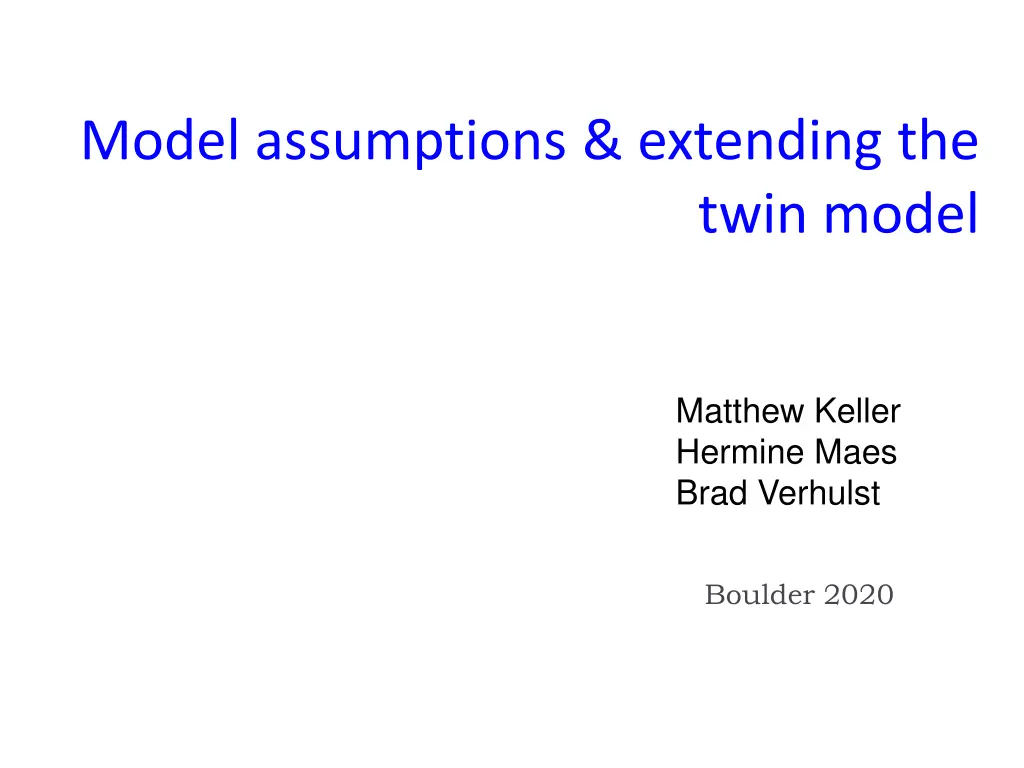
Algebraic Expectations of Variance Component Estimates
Dive into deriving biases in estimates, interpreting them with biases in mind, and minimizing bias in modeling. Understand the differences between true and estimated parameters in SEM, focusing on effect sizes over significance, causes, and consequences. Learn practical algebraic expectations for ADE models to estimate VA and VD accurately.
Download Presentation

Please find below an Image/Link to download the presentation.
The content on the website is provided AS IS for your information and personal use only. It may not be sold, licensed, or shared on other websites without obtaining consent from the author. If you encounter any issues during the download, it is possible that the publisher has removed the file from their server.
You are allowed to download the files provided on this website for personal or commercial use, subject to the condition that they are used lawfully. All files are the property of their respective owners.
The content on the website is provided AS IS for your information and personal use only. It may not be sold, licensed, or shared on other websites without obtaining consent from the author.
E N D
Presentation Transcript
Model assumptions & extending the twin model Matthew Keller Hermine Maes Brad Verhulst Boulder 2020
Files you will need are in Faculty drive: /matt/Assumptions2020 Assumptions_mck_2020.pdf (PPT presentation) CTD.ACDE-param.indet_2020.R (OpenMx script) PDFs of papers describing details of what we go over here & that correspond to the approach/notation I'm using here
Structural Equation Modeling (SEM) in BG SEM is great because Directs focus to effect sizes, not significance Forces consideration of causes and consequences Explicit disclosure of assumptions Potential weakness Parameter reification: Using the CTD we found that 50% of variation is due to VA and 20% to VC. Should you believe that 50% of variation is truly additive genetic?
True parameters vs. Estimated parameters VA VC VD VE: true (unknowable) values in the population VA , VC , VD , VE : estimated values of VA, VC, VD, VE. VA , VC , VD , VE , will differ from VA, VC, VD, VE due to: 1) sampling variability 2) bias (= E[ ] - ) This session is about deriving biases in estimates, how to interpret them in light of these biases, and how to model in ways that minimize bias
How to derive algebraic expectations of variance component estimates 1) In an ACE model, we assume VD=0. So to get algebraic expectations of VA and VC in an ACE model, write down what CVmz and CVdz are composed of: CVmz = VA + VC CVdz = VA + VC 2) To get an estimate of one term (e.g., VA) try to think of possible contrasts of linear transformations that get rid of one parameter (e.g., VC) and isolate the other (e.g., VA). Thus: CVmz CVdz = VA. Thus 2(CVmz-CVdz) = VA. Thus an estimator of VA: VA = 2(CVmz CVdz). 3) Similarly to get rid of VA and isolate VC: VC = 2CVdz - CVmz NOTE: I m using VY rather than the usual V to denote estimates of VY simply due to PPT issues!
Practical 1 algebraic expectations of ADE 1) Use what we just learned to derive algebraic expectations of the estimates of VA and VD in an ADE model (where we assume VC=0). As a hint, in this situation, we re assuming: CVmz = VA + VD CVdz = VA + VD 2) Now to get VA , think of possible contrasts of linear transformations of CVmz and CVdz that get rid of VD and isolate VA. QUESTION1.1: What is your estimator of VA (VA ) in an ADE model? 3) Now do the same to get VD QUESTION1.2: What is your estimator of VD (VD ) in an ADE model?
How to derive algebraic expectations of bias in estimates due to misspecification 1) We want to know what happens when we misspecify the model (a parameter that is non-zero in real life is omitted in the model). To get at this, first write out your estimate. E.g., in an ACE model, VA is: VA = 2*(CVmz CVdz). 2) Next consider what variance components REALLY exist in your estimates. If VD is actually non-zero, then we know: CVmz = VA + VD + VC CVdz = VA + VD + VC 3) Finally, just plug in the reality to your estimates. Thus, in an ACE: VA = 2*(VA + VD + VC VA VD VC) = VA + 3/2(VD) IN word: when VD actually exists and you fit an ACE model, VA is biased upwards by 1.5 of whatever VD truly is. 4) Similarly, VC = VC - VD. VC is biased downward by half of VD.
Practical 2 deriving biases of ADE 1) Use what we just learned to derive the bias in the VA and VD in an ADE model (where we assume VC=0). Recall that: VA = 4CVdz CVmz VD = 2CVmz 4CVdz CVmz = VA + VD + VC CVdz = VA + VD + VC 2) Now just plug in the constituent variance components into CVmz and CVdz and see how our estimates are biased. QUESTION2.1: How is VA biased in an ADE model when VC is (contrary to our assumption) actually non-zero? QUESTION2.2: How is VD biased in an ADE model when VC is (contrary to our assumption) actually non-zero?
Quiz Question 1 1) We must fix to zero (and not estimate) either VC or VD in an identified classical twin model because: [exactly two answers are correct] a) these estimates are too highly correlated (multicolinearity problems) b) you can estimate VC and VD simultaneously - you just have to fix VA to some specific value c) you can estimate VC and VD simultaneously - you just have to allow them to go negative (not use path coefficient approach) d) there are fewer informative statistics (2) than parameters to be estimated (3), thus the full ADCE model is unidentified.
The Classical Twin Design VC VD / .25VD VA / .5VA E C D A A D C E Tw1 Tw2
Why cant we estimate VC & VD at same time using twins only? Solve the following two equations for VA , VC , & VD : CVmz = VA + VD + VC CVdz = VA + VD + VC 3 unknowns, 2 informative equations. It can't be done. There are no unique solutions. The model is unidentified . In practice, you can detect non-identification by noting that (a) model estimates depend on starting values AND (b) all final models have identical likelihoods
Nonidentification: Practical 3 (using R) Open CTD.ACDE-param.indet_2020.R in R Run practical 3A to simulate data where truth is VA=.4, VD=.2, VC=.05 (and thus CVmz=.65; CVdz=.3). Pause for discussion. Run practical 3B for ADE model on this data. Pause for discussion. Run practical 3C for ACE model (which we normally wouldn t do) on same data. Pause for discussion. Run practical 3D for ADCE model (which we definitely wouldn t normally do). Pause for discussion: Write down your -2LL and your estimates of VA, VC, and VD Compare these to your neighbor s WHY are -2LL the same despite different VA , VC , and VD (that depend on arbitrary start values) Do not close CTD.ACDE-param.indet_2020.R in R
The CTD: Two statistics give info about within-family resemblance 1 1.00 / .25 1.00 / .5 E C D A A D C E Tw1 Tw2 MZ covariance DZ covariance Vp Vp Vp CVmz Vp CVdz
ACE Model 1 1.00 / .25 1.00 / .5 E C D A A D C E 0 0 By convention, fit when CVmz < 2CVdz Tw1 Tw2 Vp Vp Vp CVmz Vp CVdz
ADE Model 1 1.00 / .25 1.00 / .5 E C D A A D C E 0 0 By convention, fit when CVmz > 2CVdz Tw1 Tw2 Vp Vp Vp CVmz Vp CVdz
The CTD: Just because we cannot fit VD & VC simultaneously doesn t mean they re not there! However, when we TRY to fit an ADCE model with just twins, there are an infinite number of combinations of VA , VD , and VC that fit the data equally well = parameter indeterminacy due to model non-identification. Thus, we just have to fit either an ADE or ACE model and live with potentially biased estimates. But it s good to quantify this bias to help in interpreting those estimates.
Quiz Question 1 again what do you think now? 1) We must fix to zero (and not estimate) either VC or VD in an identified classical twin model because: [exactly two answers are correct] a) these estimates are too highly correlated (multicolinearity problems) b) you can estimate VC and VD simultaneously - you just have to fix VA to some specific value c) you can estimate VC and VD simultaneously - you just have to allow them to go negative (not use path coefficient approach) d) there are fewer informative statistics (2) than parameters to be estimated (3), thus the full ADCE model is unidentified.
So what is the advantage of estimating variances directly (without a bound) if it doesn t solve bias due to model misspecification? Foremost: valid p-values. If we bound estimates, the distribution of -2LL differences under null is not 2(it s 50% 2 & 50% with point mass at lower bound; e.g., 0). Thus inflated type-II errors. Second: eliminates a source of bias due to sampling variability. If we think about estimates being random values under repeated draws of data, whenever the estimate hits a zero bound, it creates biases in it s own estimate (up) and in other estimates (up or down). This is a separate (and probably smaller) source of bias from that due to model misspecification. Note when you directly estimate variances, it s easy to transform between VC and VD : In ADE model, VC you would have gotten in ACE = - VD In ACE model, VD you would have gotten in ADE = -2VC
Quiz Question 2 2) If the assumptions of the CTD model that either VD or VC is zero is violated (i.e., VA, VC, and VD simultaneously affect the phenotype)... [choose all that apply] a) the interpretation of the estimated parameters should be altered; e.g., VA should be considered an amalgam of VA & VD (in ACE model) or of VA & VC (in ADE model) b) there is no point in doing the analysis c) the point estimates of the estimated parameters will be biased
Bias in parameter estimates for violation of assumption that either VD or VC is 0 In ACE Models (bias induced in setting VD = 0): VA = VA + 3/2VD VC = VC VD In ADE Models (bias induced in setting VC = 0): VA = VA + 3VC VD = VD 2VC
Quiz Question 3 3) An ADE model finds that VA = .30 and VD = .10. This implies that shared environmental factors do not influence the trait in question. a) TRUE b) FALSE
Quiz Question 4 4) We run an ADE model and find that VA = .69 and that VD = .05. If in truth, VC = .10, what will the effect on the estimated parameters be? [choose all that apply] a) VA will be biased (too low) b) VA will be biased (too high) c) VD will be biased (too low) d) VD will be biased (too high) e) there is no affect on the estimated parameters; however by not estimating VC (aka, fixing it to zero), we underestimated VC
PRACTICAL 4: Sensitivity analysis Sensitivity analysis: studying what the effects are on estimated parameters when assumptions are wrong In CTD.ACDE-param.indet_2018.R, run: FROM # START PRACTICAL 4 TO # END PRACTICAL 4 Run one section at a time and change the value of VC from 0 to other possible values in an ADE model. What happens to estimates of VA and VD depending on different assumed values of VC?
Effects of epistasis on these biases Epistasis (across loci interactions) can increase the degree of the biases because it can reduce the CVdz:CVmz ratio even further than the expected 1:4 under dominance. However, the degree of bias rests on how strong non-additive genetic influences are. This is an active area of debate. Epistatic effects will generally come out in the estimates of VD. Thus, interpret VD broadly, as a rough estimate of VNA My take: VA is almost certainly greater than VNA, and evidence for much VD per se is scant. But some traits may show high enough VNA to bias estimates of VC and VD (VNA) down and VA up considerably from twin studies.
Quiz Question 5 5) What are the typical assumptions of a classical twin model? [choose all that apply] a) only genetic factors cause MZ twins to be more similar to each other than DZ twins b) either VD or VC is zero c) no epistasis d) no assortative mating e) no gene-environment interactions or correlations
What are the effects of violations of assumptions in the CTD? a) Only genetic factors cause MZ twins to be more similar to each other than DZ twins: VA and VD overestimated and VC underestimated b) Either VD or VC is zero: VA overestimated and VD & VC underestimated c) No epistasis: VD or VA overestimated and VC underestimated d) No assortative mating: VA and VD underestimated and VC overestimated e) No gene-environment interactions or correlations: AxC: VA overestimated; AxE: VE overestimated; passive Cov(A,C): VC overestimated
Assortative mating consequence on VA AM: phenotypic correlation between mating partners Many examples (e.g., height ~.2; IQ ~ .3; Social attitudes ~ .5) If AM leads to genetic similarity in partners (as it does if due to choice for similarity), there are genetic consequences: Height VA increases in the population because tall ( short ) alleles are more concentrated in individuals than expected. E.g., if you re a tall allele sitting in an egg and are waiting around to see what other height genes you ll get paired with from that sperm swimming to you, they are more likely than chance to be other tall alleles (both at the same locus and at others; & this just considers the effects on VA in 1st gen)
AM consequence on relative covariance AM increases genetic covariances and correlations between relatives (e.g., sibs, parents, cousins, etc). While CVmz increases, it s correlation is already 1 so it doesn t increase Consider again being a tall allele in a zygote. This time you are watching your co-twin s zygote get formed. Regardless of whether you exist (are IBD) in your co-twin s egg, you can expect more tall alleles swimming to your co-twin s egg. Thus, you can also expect to share more tall alleles with your sibling(s). The CVdz that is due to additive genetics is:
Quiz Question 6 6) In the CTD, say that CVmz < 2CVdz, so we fit an ACE model. How would AM tend to affect parameter estimates? [choose all that apply] a) deflates estimates of VA b) inflates estimates of VA c) deflates estimates of VC d) inflates estimates of VC
Quiz Question 7 7) Say we add parents to the CTD. That gives us 2 additional relative covariance estimate to work with (parent-offspring and spousal) in addition to the normal CVmz and CVdz and allows us to ___________ [choose all that apply] a) estimate VA, VC, & VD simultaneously b) account for effects of assortative mating c) account for passive G-E covariance d) reduce the bias in estimates of VA, VC, and VD
Classical Twin Design (CTD) Assumption biased up biased down Either VD or VC is zero VA VC & VD No assortative mating VC VD No A-C covariance VC VD & VA 1 A A 1/.25 C C E E a a c c e e D D d d PT2 PT1
Adding parents gets us around all these assumptions Assumption biased up biased down Either VD or VC is zero No assortative mating No A-C covariance We don t have to make these q q w w A A x x C C E E a a c c e e D D d d PFa PMa m m m m A A 1/.25 C C E E a a c c e e D D d d PT2 PT1
We can model VC as either VS or VF With parents, we can break VC up into: S S = env. factors shared only between sibs C F F = familial env factors passed from parents to offspring But we can only estimate one of these (or more technically, one of VA, VS, VF, & VD) 1 1 A A A A F F 1/.25 1/.25 C C S S E E E E a a f a a f c c e s s e e D D e D D d d d d PT2 PT1 PT 2 PT 1
Nuclear Twin Family Design (NTFD) w w q q A A F F x x S S E E f f a a s s e e D D d d PFa PMa m m m m Note: m estimated and f fixed to 1 zs A A F F zd S S E E f a a f s s e e D D d d PT2 PT1
PRACTICAL 5: NTFD analysis In CTD.ACDE-param.indet_2018.R, run: FROM # START PRACTICAL 5 TO # END PRACTICAL 5 What are the estimated values of VA, VD, & VS? [Note: VS = sib environment, equivalent to VC in the CTD]
Simulated (true) vs. CTD vs. NTFD results TRUE values CTD estimates NTFD estimates VA = .30 VA = .68 VA = .32 VD = .30 VD = .04 VD = .29 VS = .10 VS = 0 VS = .13 Note: these are results from a single simulation. The estimates don t equal the parameters here due to sampling variance. If we ran this a lot of times, NTFD estimates would be unbiased.
On average across 38 traits CTD vs. ETFD results* VA 65% higher in CTD VD 43% lower in CTD VC 45% lower in CTD when r(spouse)~0 VC 100% higher in CTD when r(spouse)>0 VG 18% higher in CTD ETFD results are not perfect, but theory and simulation suggest they are, on average, much more accurate than CTD results. Accuracy across all sims: CTD=.14; NTF=.07; ETFD=.045 o * Coventry & Keller, 2005
Nuclear Twin Family Design (NTFD) w w q q A A F F x x S S E E f f a a s s e e D D d d PFa PMa m m m m Note: m estimated and f fixed to 1 zs A A F F zd S S E E f a a f s s e e D D d d PT2 PT1 Assumptions: Only can estimate 3 of 4: VA, VD, VS, and VF (bias is variable) Assortative mating due to primary phenotypic assortment (bias is variable)
Stealth Include twins and their sibs, parents, spouses, and offspring Gives 17 unique covariances (MZ, DZ, Sib, P-O, Spousal, MZ avunc, DZ avunc, MZ cous, DZ cous, GP-GO, and 7 in- laws) 88 covariances with sex effects
Additional obs. covs with Stealth allow estimation of VA, VS, VD, VF, VT can be estimated simultaneously T F D S A T = env. factors shared only between twins 1 A A F F 1/.25 S S E E f a a f s s e e D D 1/0 d d d PT2 PT1 t t T T (Remember: we re not just estimating more effects. More importantly, we re reducing the bias in estimated effects although perhaps at the expense of more variance in estimates)
Stealth w w q q A A F F x x S S E E f f a a s s e e D D d d PFa PMa t t T T m m m m w w 1 q q A A F F A F A F x x 1/.25 S S S S E E E E f f a a f a f a s s s s e e e e D D D D 1/0 d d d d PT2 PMa PFa PT1 t t t T T t T T m m m m A F A F S S E E a f a f s s e e D D d d PCh PCh t t T T
Stealth Assumption biased up biased down Primary assortative mating VA, VD, or VF VA, VD, or VF No epistasis VA, VD VS No AxAge VD, VS VA
Stealth Assumption biased up biased down Primary assortative mating VA, VD, or VF VA, VD, or VF No epistasis VA, VD VS No AxAge VD, VS VA Primary AM: mates choose each other based on phenotypic similarity Social homogamy: mates choose each other due to environmental similarity (e.g., religion) Convergence: mates become more similar to each other (e.g., becoming more conservative when dating a conservative)
Cascade ~ ~ PFa PMa d~ s~ s~ d~ t~ t~ a ~~ F a ~ w w ~ q q f f ~ ~ e e A A F x x S S E E f f a a s s e e D D d d PFa PMa t t T T m m m m ~ ~ ~ ~ PT1 PT2 PSp PSp s~ d~ t~ d~ s~ t~ a ~ a ~~ F a ~ a ~~ w w ~ ~ 1 q q f f f f ~ ~ ~ s~ ~ s~ e e e e A A F A F A F d~ x x d~ 1/.25 S S S S E E E E t~ t~ f f a a f a f a s s s s e e e e D D D D 1/0 d d d d PT2 PMa PFa PT1 t t t T T t T T m m m m A F A F S S E E a f a f s s e e D D d d PCh PCh t t T T
VA,VD, & VF estimates are highly correlated in Stealth & Cascade



